Common Red Dogwood Hedge Plants
Cornus sanguinea is the native British dogwood. It's a large deciduous shrub with blood-red and green stems in spring, white flowers in summer and black fruit in September and October. It's a great country hedge plant that loves wet sites.
For more ornamental bark colours, see our selection of dogwood varieties.
Delivery season: Dogwood plants are delivered bareroot during late autumn and winter, approximately November-March inclusive.
Choosing a size: When you are ordering dogwood plants for a hedge, we generally recommend that you use plants that are graded at 40/60cm or 60/80cm. They're cheaper than large plants, easier to handle, and they'll establish well in poor conditions. Use the larger, 90/120cm high plants if you want a tall hedge quickly, or for gaps in established hedges.
All our hedge plants are measuredby their height in centimetres above the ground when planted
Features
- Height: To 3-4m
- Soil: Any, loves very wet sites with good sun
- Use: Mixed native country hedges, wildlife cover.
- Single Row: 3/m
- Double row: 6/m
- RHS Plants for Pollinators
Growing Dogwood
Like willow, dogwood really loves wet soil beside water and doesn't mind being underwater for most of the winter. However, with you to help it establish, it'll thrive in poor, dry soil just as well, especially with a good amount of sun.
Spacing a Dogwood hedge: Standard country hedging: plant at 3 per metre, 33cm apart in a single row, or 6 per metre in a staggered double row, which has a W shape viewed top-down.
Garden Design Ideas
It's a classic component of mixed native hedges; it could make a hedge by itself, but it would be relatively easy for an intruder to scramble over it. It's a bit too untidy to make it a good specimen shrub, but it can be allowed to grow freely as attractive wildlife cover, especially for water fowl in the wet locations that it loves.
History & Trivia
Known as bloody or blood-twig dogwood in America, it has a fistful of common names, including dog cherry, catteridge, gadrise, and peg or prick wood (no comment).
Former botanical names include Cornus latifolia or sylvestris and Swida sanguinea.
The name Dogwood comes from the Saxon Dagwood or "skewer-wood". The stems of Common Dogwood are very straight, can be sharpened easily and are ideal as skewers for your home-made barbecues during those long hot English summers.
Ötzi the Iceman, who was rudely awakened in the early 1990's from his 5,000 year nap, had viburnum and dogwood arrows, along with a copper axe, a stone knife, and a Yew bow.
He was promptly arrested for possession of offensive weapons without a licence, and has been incarcerated in the South Tyrol Museum of Archaeology ever since.

 Secure, One-Tap Checkout
Secure, One-Tap Checkout
 Hand Picked, Delivered to Your Door!
Hand Picked, Delivered to Your Door! 1 Year Bareroot Guarantee
1 Year Bareroot Guarantee











